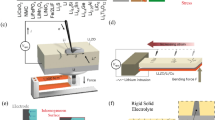Abstract
A cost-effective and reliable technology allowing extreme miniaturization of batteries into glass chips and electronic packages has been developed, employing a dispense-print process for battery electrodes and liquid electrolyte. Lithium-ion micro-batteries (active area 6 × 8 mm2, 0.15–0.3 mAh) with interdigitated electrodes were fabricated, tested and finally compared with the traditional battery architecture of stacked electrodes. Commercial graphite and lithium titanate anode as well as layered nickel cathode materials were used. All the processes for the micro-battery fabrication were established during this work; in particular the micro fluidic electrolyte filling process that allows simultaneous electrolyte supply to all cells on a planar substrate. Electrode mass reproducibility was sufficient for adequate electrode balancing. Current capability similar to the conventional face-to-face electrode configuration was achieved with interdigital electrodes that can be fabricated much easily on a substrate level. The cells were successfully cycled; several 100 cycles can be achieved. Additional results of life-time characteristics and electrochemical impedance spectroscopy are presented as well. These rechargeable micro-batteries can be used for future extremely miniaturized electronic products.







Similar content being viewed by others
References
Bates JB, Dudney NJ, Neudecker B, Ueda A, Evans CD (2000) Thin-film lithium and lithium-ion batteries. Solid State Ion 135:33–45
Bimbaud I (2017) A smart energy storage device. http://www.idtechex.com/events/presentations/a-smart-energy-storage-device-that-enables-digitalization-of-the-world-009589.asp. Accessed 29 Aug 2017
Ferrari S, Loveridge M, Beattie SD et al (2015) Latest advances in the manufacturing of 3D rechargeable lithium microbatteries. J Power Sources 286:25–46
Hahn R, Marquardt K, Thunman M, Töpper M, Wilke M, Ferch M, Huynh QH, Lang KD (2012) Silicon integrated micro batteries based on deep reactive ion etching and through silicon via technologies. In: ECTC. https://doi.org/10.1109/ectc.2012.6249045
Hahn R, Hoeppner K, Ferch M, Marquardt K, Lang K D (2014) Development of integrated lithium-ion micro batteries. In Microelectronics Packaging in the 21th Century, Chapter VIII, Fraunhofer Verlag 2014, ISBN: 978-3-8396-0826-5, pp 392–399
Hahn R, Hoeppner K, Molnar M, Ferch M, Lücking M, Hubl M, Elia AG, Marquardt K (2016) Micro battery prototype line and micro fluidic electrolyte handling. IDTechEx Energy Harvesting and Storage Europe 2016, Berlin, pp 27–28
Hahn R, Ferch M, Hoeppner K, Queisser M, Marquardt K, Elia AG (2017) Development of micro batteries based on micro fluidic MEMS packaging. IEEE. https://doi.org/10.1109/DTIP.2017.7984497
Han C, He Y-B, Li H, Li B, Du H, Qin X, Kang F (2015) Suppression of interfacial reactions between Li4Ti5O12 electrode and electrolyte solution via zinc oxide coating. Electrochim Acta 157:266–273. https://doi.org/10.1016/j.electacta.2014.12.080
Hang T, Mukoyama D, Nara H, Takami N, Momma T, Osaka T (2013) Electrochemical impedance spectroscopy analysis for lithium-ion battery using Li4Ti5O12 anode. J Power Sources 222:442–447. https://doi.org/10.1016/j.jpowsour.2012.09.010
He Y-B et al. (2012) Gassing in Li4Ti5O12-based batteries and its remedy Scientific Reports 2. https://doi.org/10.1038/srep00913
He Y-B et al (2013) Effect of solid electrolyte interface (SEI) film on cyclic performance of Li4Ti5O12 anodes for Li ion batteries. J Power Sources 239:269–276. https://doi.org/10.1016/j.jpowsour.2013.03.141
Hoeppner K, Ferch M, Froebe A, Gernhardt R, Hahn R et al (2015) Design, fabrication, and testing of Silicon-integrated Li-ion secondary micro batteries with interdigital electrodes. J Phys. https://doi.org/10.1088/1742-6596/660/1/012064
Kato Y et al (2016) High-power all-solid-state batteries using sulfide superionic conductors Nature. Energy 1:16030. https://doi.org/10.1038/nenergy.2016.30
Kyeremateng N-A (2014) Self-organized TiO2 nanotubes for 2D or 3D Li-Ion microbatteries. ChemElectroChem 1:1442–1466
Lacey MJ, Jeschull F, Edström K, Brandell D (2014) Functional, water-soluble binders for improved capacity and stability of lithium–sulfur batteries. J Power Sources 264:8–14
Ogawa M et al (2012) High capacity thin film lithium batteries. J Power Sources 205:487
Patil A, Patil V, Choi JW et al (2017) Solid Electrolytes for rechargeable thin film lithium batteries: a review. J Nanotechnol 17(1):29–71
Thunman M, Marquardt K, Hahn R (2012) Discharge performance dependence on electrode thickness for Li4Ti5O12/LiMn2O4 Cells for application in wafer-integrated microbatteries—fundamental studies. ECS Trans 41:147–157
Wang Y, Liu B, Li Q et al (2015) Litium and lithium ion batteries for application in microelectronic devices: a review. J Power Sources 286:330–345
Acknowledgements
This work is part of the MATFLEXEND project funded by the European Union under contract FP7 604093 (www.matflexend.eu), the German Federal Ministry of Education and Research in the project Hörkontaktlinse under contract 13GW0083C and the German Federal Ministry of Education and Research in the AlSiBat project under contract 03SF0486.
Author information
Authors and Affiliations
Corresponding author
Additional information
Publisher's Note
Springer Nature remains neutral with regard to jurisdictional claims in published maps and institutional affiliations.
Rights and permissions
About this article
Cite this article
Hahn, R., Ferch, M., Kyeremateng, N.A. et al. Characteristics of Li-ion micro batteries fully batch fabricated by micro-fluidic MEMS packaging. Microsyst Technol 28, 1321–1329 (2022). https://doi.org/10.1007/s00542-018-3933-z
Received:
Accepted:
Published:
Issue Date:
DOI: https://doi.org/10.1007/s00542-018-3933-z




